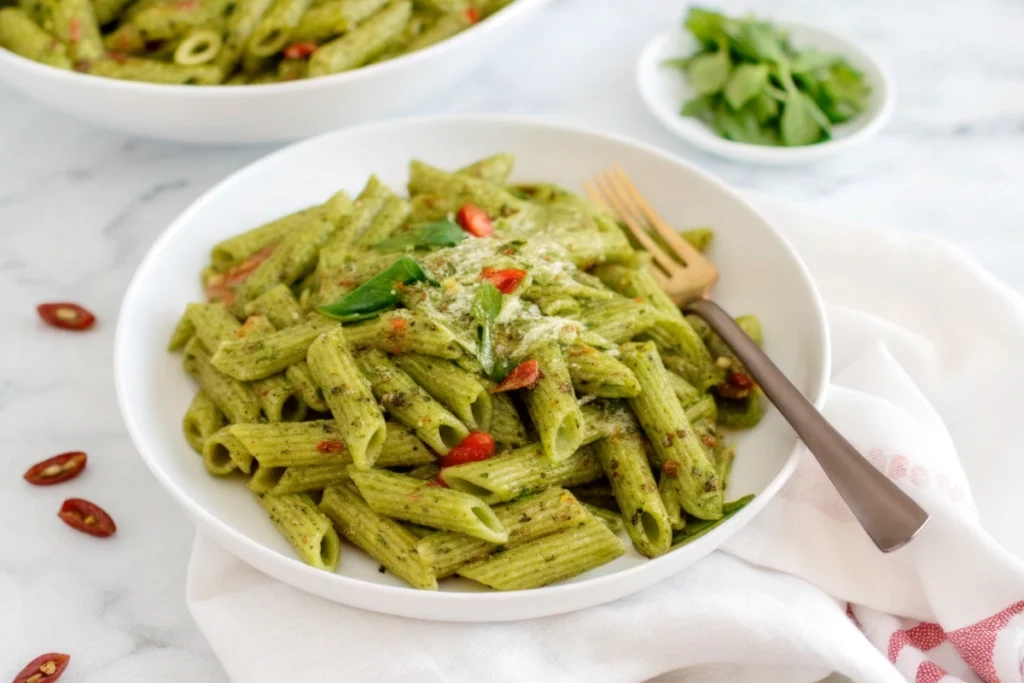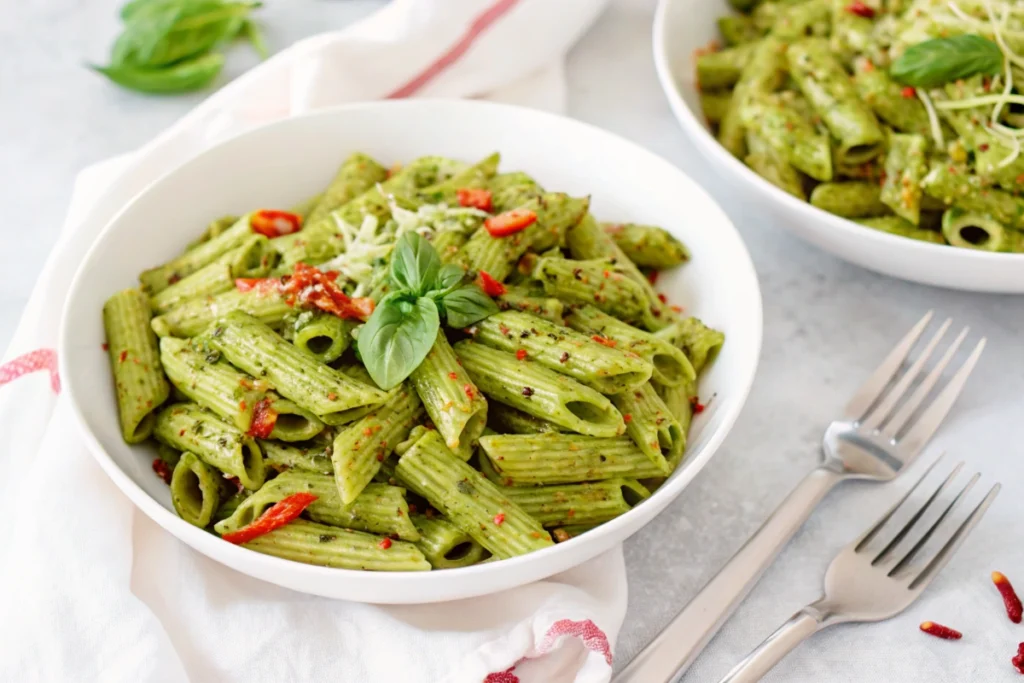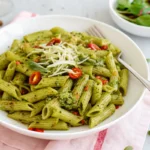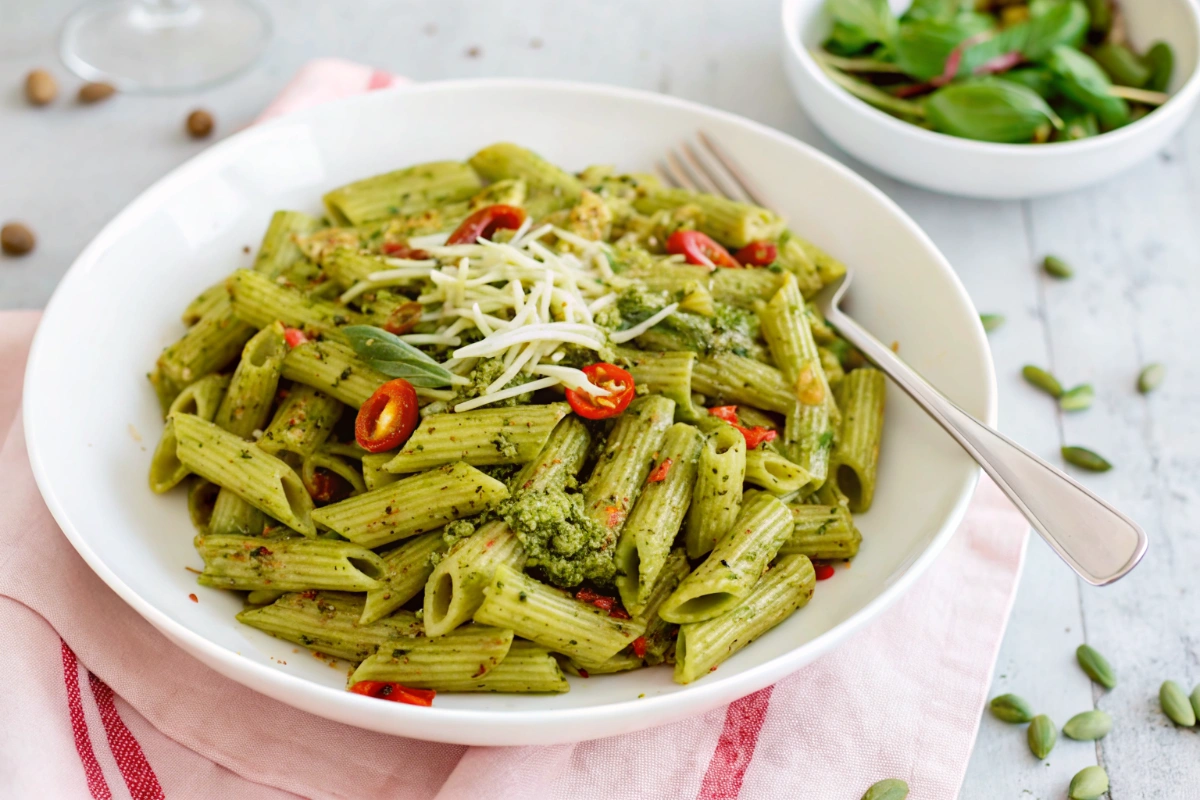Table of Contents: Pesto Pasta
Few dishes offer the same vibrant freshness and comforting simplicity as pesto pasta. With just a handful of ingredients—fresh basil, garlic, pine nuts, Parmesan, and olive oil—you can craft a sauce that turns plain pasta into a restaurant-worthy experience.
This guide goes beyond the basics. We’ll dive into the history of pesto, explore traditional and modern recipes, unlock expert-level cooking science, and recommend smart pairings. You’ll even find internal links to helpful content like how to marry pasta with sauce and how to boil pasta al dente.
Whether you’re new to pesto pasta or want to elevate your go-to version, this article has everything you need.
A Brief History of Pesto
Pesto alla Genovese hails from Genoa in the Liguria region of northern Italy. The word “pesto” comes from the Italian pestare, meaning “to crush,” because the original recipe was made using a mortar and pestle.
The first written recipes date back to the 1800s, but similar herb-and-nut-based sauces were enjoyed in ancient Rome. The iconic green pesto we know today became widespread thanks to the Genoese seafaring trade, which helped distribute ingredients like olive oil and pine nuts.
If you’re curious about its roots, check out this insightful post from the Slow Food Foundation, which traces pesto’s cultural legacy.
What Is Pesto Pasta?
At its simplest, pesto pasta is cooked noodles tossed with pesto sauce. But when done right, it becomes much more:
- Creamy from the emulsification of pasta water and olive oil
- Rich with cheese and nuts
- Bright and herbal from fresh basil
Ideal pasta types include:
- Trofie (traditional in Liguria)
- Fusilli (great for sauce cling)
- Spaghetti or linguine
- Penne (for cold or baked dishes)
Wondering which pasta works best for your sauce? This Serious Eats pasta shape guide explains why shape matters.
Ingredients for Perfect Pesto Pasta

Traditional Pesto alla Genovese
- 2 cups fresh basil leaves (packed)
- ¼ cup pine nuts (toasted for more flavor)
- 2 cloves garlic
- ½ cup grated Parmesan cheese
- ½ cup extra virgin olive oil
- Salt to taste
Recommended Pasta
- 400g spaghetti, fusilli, or penne
- Salted water for boiling
- Reserved pasta water
Optional Add-ins
- Lemon zest for brightness
- Mozzarella pearls for creaminess
- Cherry tomatoes or sun-dried tomatoes
- Grilled chicken — and yes, it pairs great (see does chicken go in pasta?)
- Tofu or shrimp for added protein
How to Make Pesto Pasta: Step-by-Step
Let’s break it down clearly.
Step 1: Cook the Pasta
- Bring water to a boil, add salt.
- Cook pasta until al dente. Not sure what that means? Follow this guide on how to boil pasta al dente.
- Reserve 1 cup of pasta water before draining.
Step 2: Make the Pesto
You can use:
- Mortar and pestle (traditional, deeper flavor)
- Blender or food processor (modern and faster)
Blend:
- Basil, pine nuts, garlic, and cheese until crumbly.
- Slowly drizzle in olive oil until smooth.
Step 3: Combine with Pasta
- Toss hot pasta with pesto.
- Add pasta water little by little while stirring to create a creamy emulsion. Learn how this works in how to marry pasta with sauce.
- Top with extra cheese and black pepper.
Cooking Science: Why Emulsification Matters
Ever wonder why restaurant pesto pasta feels so silky?
That’s thanks to emulsification — the blending of olive oil with starchy pasta water to create a cohesive sauce. Pasta water helps bind the oil-based pesto to the noodles, preventing clumping or dryness.
Pro Tip: Avoid rinsing pasta. It removes surface starch and kills your sauce’s texture!
Pesto Pasta Variations & Flavor Combos
Different Pesto Styles
- Kale or spinach pesto – earthy and winter-friendly
- Arugula pesto – peppery with a spicy kick
- Sun-dried tomato pesto – tangy and umami-rich
- Avocado pesto – super creamy and healthy
- Vegan pesto – uses nutritional yeast instead of cheese
Global Fusions
- Japanese miso pesto with soba noodles
- Mexican cilantro-jalapeño pesto
- French-style pistou with tomatoes
Best Proteins to Add
Pair your pesto pasta with:
- Grilled chicken
→ See: does chicken go in pasta? - Shrimp
→ Try this twist: Argentine shrimp with linguine - Tofu for a plant-based version
- Italian sausage or pancetta for richness
Side Dishes That Complement Pesto Pasta

Balance your meal with:
- Caprese salad (mozzarella, tomato, basil)
- Roasted zucchini or bell peppers
- Garlic bread
- Lemony kale salad
- Soup, like a chilled tomato gazpacho
Cold Pesto Pasta Salad
Want a summery version? Pesto pasta salad is ideal for picnics or lunches.
Ingredients:
- 300g fusilli or penne
- 1 cup cherry tomatoes
- ½ cup pesto
- ¼ cup Parmesan
- Optional: olives, cucumbers, red onion
Mix together and chill. Serve with lemon juice and a drizzle of olive oil.
Storage & Meal Prep Tips
- Fridge: Store in airtight container for up to 3 days.
- Freezer: Freeze pesto in ice cube trays, then store in bags for up to 3 months.
- Reheating: Add a splash of water or oil to rehydrate sauce when microwaving.
Tip: When storing leftover pesto, cover with a thin layer of olive oil to prevent oxidation.
FAQs About Pesto Pasta
What is pesto pasta made of?
Pasta tossed with pesto sauce made of basil, pine nuts, garlic, cheese, and olive oil.
Can I make it vegan?
Yes. Use nutritional yeast instead of cheese and skip Parmesan.
Is pesto pasta healthy?
Generally, yes. It’s full of healthy fats and antioxidants. Use whole wheat pasta or serve with veggies to make it even better.
Can I use different nuts?
Definitely. Swap pine nuts for walnuts, almonds, or even sunflower seeds.
Why does my pesto taste bitter?
Possible causes:
- Over-blending (olive oil turns bitter with excess blade contact)
- Old basil
- Too much garlic
Can I serve it cold?
Absolutely. In fact, it’s perfect for a 4-ingredient pasta salad or as part of a lunch box meal.
Nutritional Profile (Per Serving Estimate)
- Calories: 500–600
- Fat: 25g (mostly healthy monounsaturated fats)
- Protein: 10–15g
- Carbs: 45–55g
- Sugar: <3g
Boost fiber and protein by using:
- Whole wheat pasta
- Lentil or chickpea pasta
- Tofu, shrimp, or chicken as toppings
For a more precise breakdown, use the USDA Nutritional Database.
Things That Help
Here are the helpful ideas used throughout this guide:
- Does chicken go in pasta?
- How to boil pasta al dente
- How to marry pasta with sauce
- Argentine shrimp with linguine
- 4-ingredient pasta salad
Conclusion: Pesto Pasta
Pesto pasta is one of those rare dishes that balances elegance with simplicity. With endless customizations and universally loved flavors, it’s a recipe every home cook should master.
Whether you’re serving it hot or cold, creamy or vegan, with chicken or shrimp, the humble pesto base opens the door to culinary creativity. Next time you’re stuck on what to make, grab some basil and pasta — and transform the ordinary into the extraordinary.
Print
THE BEST Pesto Pasta at Home
- Total Time: 25 minutes
- Yield: 4 servings 1x
- Diet: Vegetarian
Description
A vibrant, fresh and herbaceous Pesto Pasta made with classic Pesto alla Genovese and your favorite pasta. Perfectly creamy, nutty, and packed with bold Italian flavor.
Ingredients
- 2 cups fresh basil leaves (packed)
- ¼ cup pine nuts (toasted for more flavor)
- 2 cloves garlic
- ½ cup grated Parmesan cheese
- ½ cup extra virgin olive oil
- Salt to taste
- 400g spaghetti, fusilli, or penne
- Salted water for boiling
- Reserved pasta water
- Optional: Lemon zest for brightness
- Optional: Mozzarella pearls for creaminess
- Optional: Cherry tomatoes or sun-dried tomatoes
- Optional: Grilled chicken
- Optional: Tofu or shrimp for added protein
Instructions
- Toast the pine nuts in a dry pan over medium heat until golden and fragrant, then set aside to cool.
- In a food processor or blender, combine basil, garlic, pine nuts, and Parmesan. Pulse until roughly chopped.
- While blending, slowly drizzle in olive oil until smooth. Season with salt to taste.
- Boil pasta in salted water until al dente. Reserve 1 cup of pasta water and then drain.
- Toss the hot pasta with the pesto, adding reserved water as needed to achieve desired consistency.
- Optional: Mix in lemon zest, mozzarella pearls, cherry tomatoes, grilled chicken, tofu, or shrimp.
- Serve immediately with extra Parmesan if desired.
Notes
Use freshly packed basil and high-quality Parmesan for the best flavor. Add protein or veggies to suit your preferences.
- Prep Time: 10 minutes
- Cook Time: 15 minutes
- Category: Main Dish
- Method: Boiled
- Cuisine: Italian
Nutrition
- Serving Size: 1 plate
- Calories: 520
- Sugar: 2g
- Sodium: 340mg
- Fat: 34g
- Saturated Fat: 7g
- Unsaturated Fat: 25g
- Trans Fat: 0g
- Carbohydrates: 38g
- Fiber: 3g
- Protein: 12g
- Cholesterol: 15mg
Keywords: pesto, pasta, Italian, basil, vegetarian, quick dinner

